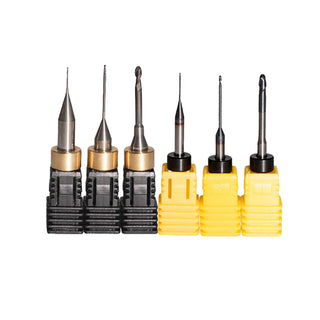Dental burs are essential tools in restorative dentistry, but their rapid wear often increases clinic operational costs. Studies show that improper handling can shorten bur lifespan by 30%-50%. This article outlines 5 evidence-based strategies to maximize bur longevity, combining scientific parameters and clinical expertise.
1. Optimize RPM Settings: Avoid Overloading and Idling
-
Low RPM (<15,000): Ideal for hard materials (e.g., zirconia) to minimize diamond coating (delamination) caused by overheating.
-
High RPM (>30,000): Best for soft resins to prevent material adhesion and bur clogging.
⚠️ Critical Reminders:
-
Never use zirconia-specific burs at high speeds for resin cutting—clogging accelerates wear.
-
Always use a speed-adjustable handpiece for precision control.
2. Cooling Strategies: Water Spray vs. Air Cooling
Prioritize Water Spray for Hard Materials
-
Zirconia/Metal Cutting: Mandatory water spray cooling (≥50ml/min flow rate) to prevent thermal degradation of the bur coating.
-
Resin/Wax Trimming: Switch to air cooling to maintain visibility without water interference.
Cooling Angle Optimization
-
Common Mistake: Directing coolant toward the bur shank (ineffective cooling).
-
Best Practice: Aim the nozzle at the bur head-material contact point (improves cooling efficiency by 60%).
3. Pressure Control: Light Touch vs. Over-Pressing
Axial Pressure Thresholds
-
Safe Limit: ≤2N (≈200g force).
-
Risk of Over-Pressing: Every 1N increase in pressure accelerates bur wear by 40%.
Clinical Techniques
-
"30% Pressure, 70% RPM": Let the handpiece’s speed—not manual force—drive cutting.
-
"Stepwise Cutting": For hard materials, perform 2-3 gradual passes instead of aggressive single-pass grinding.
4. Cleaning & Sterilization: Avoid Hidden Damage
Sterilization Guidelines
| Bur Type | Recommended Sterilization | Prohibited Methods |
|---|---|---|
| Diamond-Coated Burs | Low-temperature plasma | Autoclaving (>135°C) |
| Tungsten Carbide Burs | Chemical immersion | Ultrasonic cleaning (causes microcracks) |
Daily Maintenance Tips
-
Wipe burs immediately with 75% alcohol wipes to remove debris and prevent resin hardening.
-
Store burs in magnetic bur holders to avoid coating damage from collisions.
5. Bur Selection: Match Design to Clinical Needs
Grit Size Recommendations
-
Coarse Grit (>100μm): Efficient for bulk zirconia removal but leaves rough surfaces.
-
Fine Grit (<40μm): Ideal for glass ceramic polishing but slower cutting.
✔️ Pro Tips:
-
Sequential Use: Start with #12 coarse burs for initial reduction, then switch to #30 fine burs for finishing.
-
Specialized Burs: Use internally cooled burs (e.g., Komet 856G) to boost cooling efficiency by 35%.
Conclusion: Monitor Wear and Replace Timely
-
Self-Check Method: Glide the bur over plaster—if it slips noticeably, replace it immediately.
-
Cost Efficiency: A bur used over 20 times reduces cost-per-use to 0.70, far lower than premature replacement.

